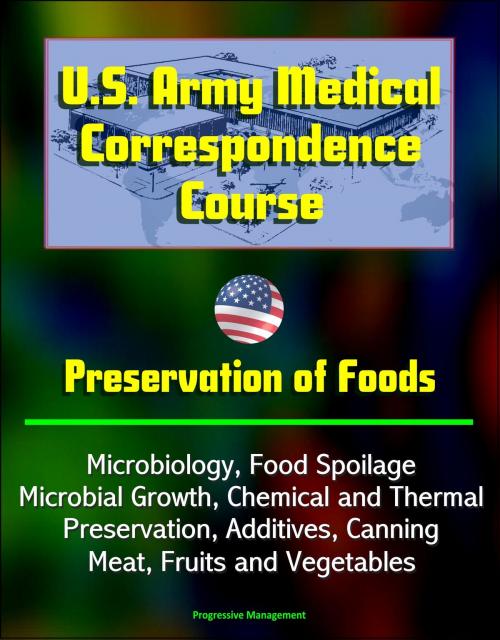U.S. Army Medical Correspondence Course: Preservation of Foods, Microbiology, Food Spoilage, Microbial Growth, Chemical and Thermal Preservation, Additives, Canning, Meat, Fruits and Vegetables
Nonfiction, Health & Well Being, Medical, Ailments & Diseases, Infectious Diseases, General, Food & Drink, Professional| Author: | Progressive Management | ISBN: | 9781311665102 |
| Publisher: | Progressive Management | Publication: | October 15, 2014 |
| Imprint: | Smashwords Edition | Language: | English |
| Author: | Progressive Management |
| ISBN: | 9781311665102 |
| Publisher: | Progressive Management |
| Publication: | October 15, 2014 |
| Imprint: | Smashwords Edition |
| Language: | English |
How do bacteria reproduce? Does the bacterial cell contain a nucleus? What are the shapes of bacteria? If you cannot answer these questions now, you should be able to when you have completed this subcourse, and you should also know the answers to many other questions. For those of you who already know this material, let it serve as a review.
Why are we interested in bacteria? Because some bacteria are capable of waging war on the human race and some bacteria are capable of benefiting our lives. We need to know the difference. Bacteria are microorganisms and microorganisms are the smallest of all organisms; for example, 2,000 of them can be lined up across the head of a common pin. In this subcourse, we will be concerned with those tiny organisms that are unfriendly, because they are responsible for a large percentage of spoilage in foods. We believe it is important to know about those microorganisms that cause food deterioration so that we can eliminate deterioration in foods before it occurs.
This subcourse is approved for resident and correspondence course instruction. It reflects the current thought of the Academy of Health Sciences and conforms to printed Department of the Army doctrine as closely as currently possible.
LESSON 1 - INTRODUCTION TO MICROBIOLOGY * Section I. Agents Causing Food Spoilage * Section II. Microbial Growth * LESSON 2 - FOOD MICROBIOLOGY * Section I. Microbiology of Dairy Products * Section II. Microbiology of Meats * Section III. Microbiology of Poultry and Shell Eggs * Section IV. Microbiology of Fruits and Vegetables * LESSON 3 - FOOD PRESERVATION * Section I. Introduction to Preservation of Foods * Section II. Methods of Preservation Addition of Chemicals * Section III. Methods of Preservation-Thermal Methods * Section IV. Preservation of Fruits and Vegetables * Section V. Food Additives * Section VI. Aseptic Storage System for Canning * Exercises
How do bacteria reproduce? Does the bacterial cell contain a nucleus? What are the shapes of bacteria? If you cannot answer these questions now, you should be able to when you have completed this subcourse, and you should also know the answers to many other questions. For those of you who already know this material, let it serve as a review.
Why are we interested in bacteria? Because some bacteria are capable of waging war on the human race and some bacteria are capable of benefiting our lives. We need to know the difference. Bacteria are microorganisms and microorganisms are the smallest of all organisms; for example, 2,000 of them can be lined up across the head of a common pin. In this subcourse, we will be concerned with those tiny organisms that are unfriendly, because they are responsible for a large percentage of spoilage in foods. We believe it is important to know about those microorganisms that cause food deterioration so that we can eliminate deterioration in foods before it occurs.
This subcourse is approved for resident and correspondence course instruction. It reflects the current thought of the Academy of Health Sciences and conforms to printed Department of the Army doctrine as closely as currently possible.
LESSON 1 - INTRODUCTION TO MICROBIOLOGY * Section I. Agents Causing Food Spoilage * Section II. Microbial Growth * LESSON 2 - FOOD MICROBIOLOGY * Section I. Microbiology of Dairy Products * Section II. Microbiology of Meats * Section III. Microbiology of Poultry and Shell Eggs * Section IV. Microbiology of Fruits and Vegetables * LESSON 3 - FOOD PRESERVATION * Section I. Introduction to Preservation of Foods * Section II. Methods of Preservation Addition of Chemicals * Section III. Methods of Preservation-Thermal Methods * Section IV. Preservation of Fruits and Vegetables * Section V. Food Additives * Section VI. Aseptic Storage System for Canning * Exercises















